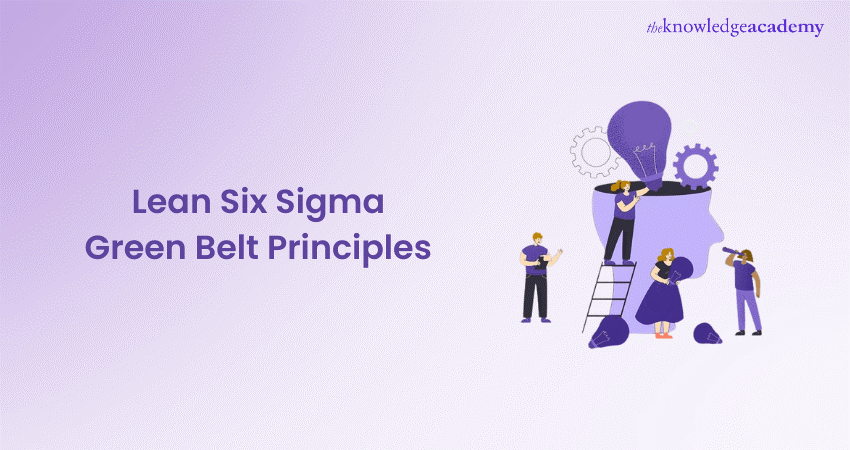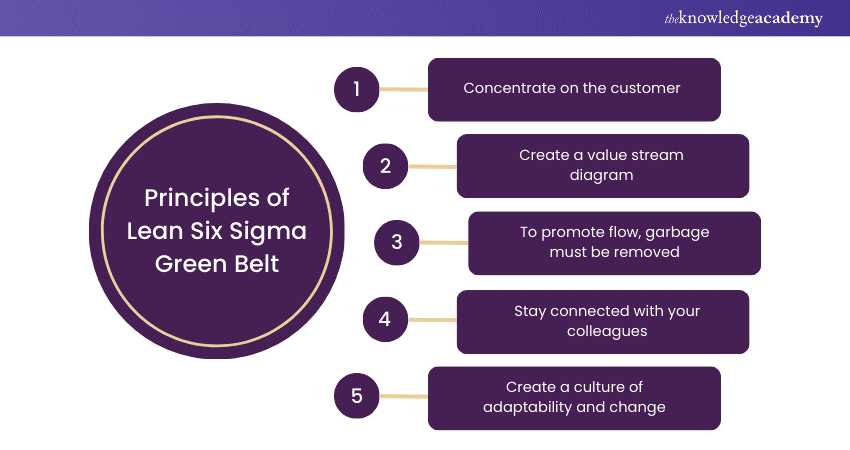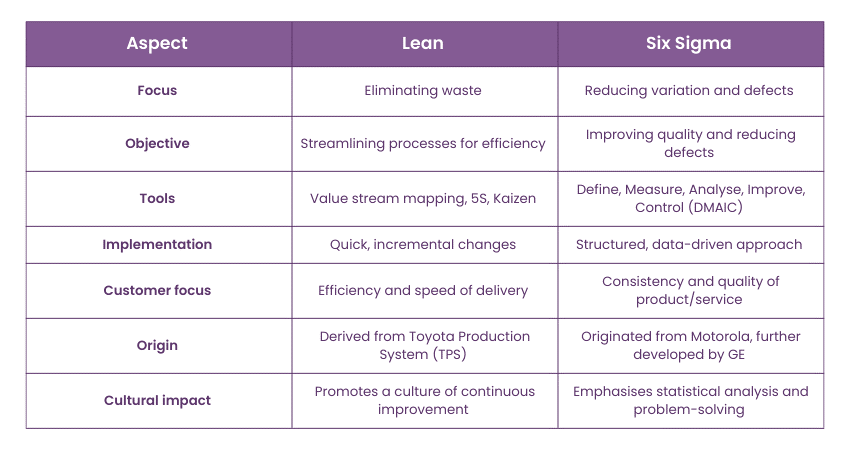We may not have the course you’re looking for. If you enquire or give us a call on +41 315281584 and speak to our training experts, we may still be able to help with your training requirements.
Training Outcomes Within Your Budget!
We ensure quality, budget-alignment, and timely delivery by our expert instructors.

Lean Six Sigma Green Belt Principles offer a structured approach to process improvement, combining the core principles of Lean manufacturing and Six Sigma methodology. This fusion prioritises waste elimination, variation reduction, and continuous improvement, resulting in better operational performance and customer satisfaction.
In this blog, you’ll learn about the core Lean Six Sigma Green Belt Principles. You’ll also examine how these methodologies drive efficiency, quality, and innovation in organisations across various industries. Read this blog further to learn more!
Table of Contents
1) What is Lean Six Sigma?
2) Core Principles of Lean Six Sigma Green Belt
3) Why are Lean Six Sigma Principles gaining popularity?
4) Difference between Lean and Six Sigma
5) Conclusion
What is Lean Six Sigma?
Lean Six Sigma combines the waste reduction method of Lean manufacturing with the fault reduction approach of Six Sigma. Its goals include removing unnecessary duties and systematically recognising and eliminating errors to improve efficiency and quality. Organisations can increase efficiency, simplify procedures, and provide higher-quality goods and services by combining these ideas.
Lean Six Sigma's methodology enables businesses to achieve operational excellence by continuously refining processes, thereby ensuring customer satisfaction and maintaining a competitive edge in today's dynamic market landscape.
Core Principles of Lean Six Sigma Green Belt
In Lean Six Sigma Green Belt Training, practitioners learn fundamental principles to guide their approach to process improvement and problem-solving. These principles serve as the foundation for achieving efficiency, quality, and innovation within organisations. Let's delve into the core principles of Lean Six Sigma Green Belt:

1) Concentrate on the customer
In Lean Six Sigma, focusing on the customer entails a deep understanding of their needs, preferences, and expectations. By prioritising the customer, organisations can align their processes and resources to deliver products and services that not only meet but exceed customer satisfaction.
Organisations following a customer-centric strategy are constantly looking for ways to improve their target audience, which motivates them to examine data, seek feedback, and adjust their plans. Organisations can attain ranging from success in the current competitive business landscape by prioritising the customer and improving customer loyalty and market share.
Businesses may improve customer loyalty and grow their market share by prioritising the needs of their customers. In today's competitive business environment, this strategy ultimately results in long-term success.
2) Create a value stream diagram
Value stream mapping, a cornerstone of Lean Six Sigma Green Belt projects, offers a potent means of process analysis. Visual representation delineates the flow of materials and information essential for product or service delivery.
This method empowers practitioners to pinpoint inefficiencies, identify bottlenecks, and unearth areas ripe for enhancement. By scrutinising each step in the value stream, Green Belt professionals gain insights into areas of waste and redundancy, facilitating targeted improvements for streamlined operations.
Ultimately, value stream mapping serves as a strategic compass, guiding organisations towards optimised processes, enhanced productivity, and improved customer satisfaction. Its systematic approach enables Green Belt practitioners to drive tangible and sustainable improvements, aligning operations with organisational objectives and fostering a culture of continuous enhancement.
Advance your career with Lean Six Sigma Green Belt Training - join now!
3) To promote flow, garbage must be removed
The core of the Lean Six Sigma methodology is waste elimination, which aims to improve efficiency and optimise processes. Through the process of carefully identifying and eliminating "garbage," or non-value-added tasks, organisations can improve overall operational efficiency, minimise lead times, and streamline workflow.
Examining every stage of the workflow is part of this process to distinguish between actions that add value and those that don't. Lean Six Sigma practitioners may develop smoother, more efficient processes that maximise productivity and resource utilisation by eliminating unnecessary elements.
In the end, waste reduction improves operational effectiveness and helps businesses offer goods and services more successfully, which raises customer satisfaction and promotes long-term economic success.
4) Stay connected with your colleagues
Maintaining relationships with coworkers is essential to the success of projects in Lean Six Sigma. Engaging in active communication and collaboration with team members, stakeholders, and subject matter experts is vital for Green Belt practitioners.
Practitioners can take advantage of the team's unique experience by encouraging open communication and insight sharing to pinpoint underlying issues, create workable solutions, and carry out long-lasting enhancements. By ensuring that all parties involved are in agreement with the project's goals, this cooperative approach increases support and buy-in for change initiatives.
In the end, Green Belts may leverage the team's collective knowledge by working well together and communicating, which leads to significant advancements in process optimisation and organisational excellence.
5) Create a culture of adaptability and change
Promoting a culture of flexibility and change is crucial for adhering to Lean Six Sigma Green Belt concepts. It is important for organisations to establish a work atmosphere that fosters adaptability, ongoing education, and creativity among their staff members.
Teams can adapt to changing consumer demands and market trends with greater effectiveness because to this culture. Organisations may generate continuous improvement and preserve a competitive edge by remaining adaptable and receptive to new ideas.
Accepting change empowers employees to identify improvements, implement new procedures, and foster creativity throughout the organisation. Organisations embracing flexibility and change are more resilient and responsive in today's fast-paced commercial environment.
Take your expertise to the next level. Join Lean Six Sigma Master Black Belt Upgrade Course now!
Why are Lean Six Sigma Principles gaining popularity?
Here are the reasons Lean Six Sigma Green Belt Principles gain popularity
1) Cost reduction: Organisations may find and remove waste with the use of the Lean Six Sigma approach, which significantly reduces costs. Businesses can increase profitability by improving workflows and enhancing productivity.
2) Improved quality: Green Belt principles focus on reducing defects and variation in processes, resulting in higher-quality products and services. This enhances customer satisfaction and builds a brand reputation.
3) Data-driven decision-making: Making educated decisions is highlighted by Lean Six Sigma through data analysis and statistical methods. By using an empirical strategy, companies can identify the underlying causes of issues and put focused solutions into action.
4) Competitive advantage: Businesses can get an advantage in the market by implementing Lean Six Sigma methods. Companies that have a longer reputation for offering excellent goods and services at affordable rates are more likely to be successful.
5) Employee development: Employee problem-solving abilities are improved, and a continuous improvement culture is created through training in Lean Six Sigma methods. This empowerment enables them to contribute significantly to organisational success.
Elevate your efficiency with 6S Training - join now for enhanced workplace productivity!
Difference between Lean and Six Sigma
In today's business landscape, organisations are constantly seeking methodologies to enhance efficiency and optimise processes. Two widely adopted approaches in this endeavour are Lean and Six Sigma. Let's delve into the key differences between these methodologies.

Boost workplace efficiency with our 5S Training - Sign up today!
Conclusion
Lean Six Sigma Green Belt Principles provide organisations with a structured approach to process improvement, driving efficiency, quality, and innovation. Prioritising customer focus, waste elimination, and continuous improvement enable companies to achieve operational excellence and sustainable success.
Master Lean principles with Certified Lean Foundation and Practitioner Training - join now!
Frequently Asked Questions

Lean Six Sigma is typically managed and overseen by trained professionals within organisations. These include Project Managers and certified Lean Six Sigma practitioners, known as Green Belts, Black Belts, or Master Black Belts.

Yes, it's possible to obtain Six Sigma Green Belt certification without prior experience. Many training programs offer Green Belt Certification Courses that are accessible to individuals at various experience levels.

The Knowledge Academy takes global learning to new heights, offering over 30,000 online courses across 490+ locations in 220 countries. This expansive reach ensures accessibility and convenience for learners worldwide.
Alongside our diverse Online Course Catalogue, encompassing 17 major categories, we go the extra mile by providing a plethora of free educational Online Resources like News updates, Blogs, videos, webinars, and interview questions. Tailoring learning experiences further, professionals can maximise value with customisable Course Bundles of TKA.

The Knowledge Academy’s Knowledge Pass, a prepaid voucher, adds another layer of flexibility, allowing course bookings over a 12-month period. Join us on a journey where education knows no bounds.

The Knowledge Academy offers various Lean Six Sigma Certification Training, including Lean Six Sigma Green Belt, Lean Six Sigma Yellow Belt, Lean Six Sigma Black Belt and Lean Six Sigma Master Black Belt Upgrade. These courses cater to different skill levels, providing comprehensive insights into Evolution of Six Sigma.
Our Business Improvement Blogs cover a range of topics related to Lean Six Sigma, offering valuable resources, best practices, and industry insights. Whether you are a beginner or looking to advance your Lean Six Sigma skills, The Knowledge Academy's diverse courses and informative blogs have you covered.
Upcoming Business Improvement Resources Batches & Dates
Date
 Lean Six Sigma Green Belt
Lean Six Sigma Green Belt
Tue 7th May 2024
Mon 13th May 2024
Sat 18th May 2024, Sun 19th May 2024
Mon 20th May 2024
Tue 28th May 2024
Mon 3rd Jun 2024
Mon 10th Jun 2024
Mon 17th Jun 2024
Sat 22nd Jun 2024, Sun 23rd Jun 2024
Mon 24th Jun 2024
Mon 1st Jul 2024
Mon 8th Jul 2024
Mon 15th Jul 2024
Sat 20th Jul 2024, Sun 21st Jul 2024
Mon 22nd Jul 2024
Mon 29th Jul 2024
Mon 5th Aug 2024
Mon 12th Aug 2024
Sat 17th Aug 2024, Sun 18th Aug 2024
Mon 19th Aug 2024
Tue 27th Aug 2024
Mon 2nd Sep 2024
Mon 9th Sep 2024
Sat 14th Sep 2024, Sun 15th Sep 2024
Mon 16th Sep 2024
Mon 23rd Sep 2024
Mon 30th Sep 2024
Mon 7th Oct 2024
Sat 12th Oct 2024, Sun 13th Oct 2024
Mon 14th Oct 2024
Mon 21st Oct 2024
Mon 28th Oct 2024
Mon 4th Nov 2024
Sat 9th Nov 2024, Sun 10th Nov 2024
Mon 11th Nov 2024
Mon 18th Nov 2024
Mon 25th Nov 2024
Mon 2nd Dec 2024
Sat 7th Dec 2024, Sun 8th Dec 2024
Mon 9th Dec 2024
Mon 16th Dec 2024







 Top Rated Course
Top Rated Course



 If you wish to make any changes to your course, please
If you wish to make any changes to your course, please


